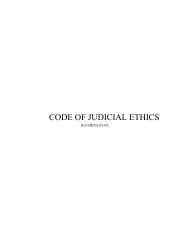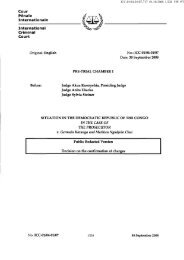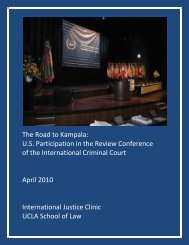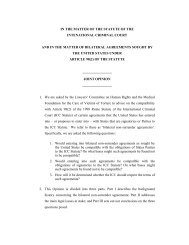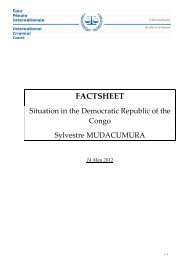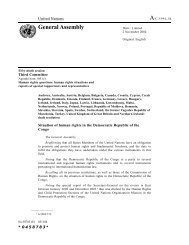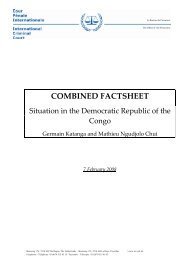NGO Media Outreach: Using the Media as an Advocacy Tool - AMICC
NGO Media Outreach: Using the Media as an Advocacy Tool - AMICC
NGO Media Outreach: Using the Media as an Advocacy Tool - AMICC
- TAGS
- using
- advocacy
- tool
- amicc
- www.amicc.org
You also want an ePaper? Increase the reach of your titles
YUMPU automatically turns print PDFs into web optimized ePapers that Google loves.
<strong>NGO</strong> <strong>Media</strong> <strong>Outreach</strong>: <strong>Using</strong> <strong>the</strong> <strong>Media</strong> <strong>as</strong> <strong>an</strong><br />
<strong>Advocacy</strong> <strong>Tool</strong><br />
Produced by <strong>the</strong> Coalition for <strong>the</strong> International Criminal Court, September 2003<br />
I. Harnessing <strong>the</strong> Power of <strong>the</strong> <strong>Media</strong><br />
A. The Import<strong>an</strong>ce of <strong>the</strong> <strong>Media</strong> to <strong>the</strong> Work of <strong>NGO</strong>s<br />
� M<strong>as</strong>s media are ch<strong>an</strong>nels, such <strong>as</strong> newspapers, magazines, radio or television,<br />
used to communicate information to large groups of people.<br />
� By regularly conveying information to import<strong>an</strong>t audiences, from <strong>the</strong> general<br />
public to government <strong>an</strong>d international decision makers, <strong>the</strong> media plays a large<br />
role in shaping public debate.<br />
� The media are among <strong>the</strong> most import<strong>an</strong>t allies to <strong>the</strong> <strong>NGO</strong> community.<br />
Establishing good relationships with journalists is <strong>an</strong> integral part of <strong>an</strong>y effective<br />
media outreach campaign.<br />
� Some ways in which <strong>the</strong> media c<strong>an</strong> be of import<strong>an</strong>ce to <strong>NGO</strong>s include writing<br />
articles that:<br />
• create <strong>an</strong> environment of political pressure<br />
• convey general information, serving <strong>as</strong> a public education tool<br />
• counter popular misconceptions<br />
• comment on <strong>an</strong> issue, providing <strong>an</strong> alternative viewpoint<br />
B. How to Establish <strong>Media</strong> Contacts<br />
� While journalists face tight deadlines each day, <strong>the</strong>y will make time to talk to you<br />
if you c<strong>an</strong> prove that you are a valuable source of information. In order to<br />
establish yourself <strong>as</strong> a valuable contact to a journalist, you must first do some<br />
work in preparation.<br />
� A good first step is to make a list of <strong>the</strong> newspaper, radio <strong>an</strong>d/or television media<br />
outlets with which you would like to establish a relationship. These are your<br />
target media contacts.
� Research what kind of stories your target media contacts cover. To do this, read,<br />
listen to or watch <strong>the</strong> reporting that your target media contacts produce. You c<strong>an</strong><br />
also use Internet search engines to review p<strong>as</strong>t coverage. Pay close attention <strong>an</strong>d<br />
try to identify one or two journalists who regularly write stories relev<strong>an</strong>t to <strong>the</strong><br />
subject matter of your media outreach campaign.<br />
� Once you’ve done this b<strong>as</strong>ic homework, call your target media contacts. Be<br />
prepared to introduce yourself <strong>an</strong>d your org<strong>an</strong>ization, <strong>an</strong>d to position yourself <strong>as</strong> a<br />
resource to that journalist. Be succinct; ch<strong>an</strong>ces are you will only have one or two<br />
minutes of <strong>the</strong> journalist’s time.<br />
� Direct journalists to web sites <strong>an</strong>d o<strong>the</strong>r resources that provide background<br />
information relev<strong>an</strong>t to your issue. The CICC h<strong>as</strong> <strong>an</strong> online press room at<br />
www.iccnow.org/pressroom.html with numerous fact sheets <strong>an</strong>d press rele<strong>as</strong>es.<br />
� Keep a comprehensive datab<strong>as</strong>e of journalist contacts once you’ve established<br />
<strong>the</strong>m. Notes you’ll w<strong>an</strong>t to include are: full name, media outlet, journalist title,<br />
telephone <strong>an</strong>d fax numbers, email address, city, country <strong>an</strong>d <strong>an</strong>y special<br />
information <strong>the</strong> journalist h<strong>as</strong> provided you.<br />
� Respect that journalists are const<strong>an</strong>tly bombarded with communications materials.<br />
Even if a news item seems import<strong>an</strong>t to you, it may not be considered<br />
newsworthy by your target media outlet. To avoid frustrating your journalist<br />
contacts, contact <strong>the</strong>m only in regards to your most urgent communications.<br />
� Respect journalists’ deadlines. If your target journalist is working under deadline<br />
between 2 <strong>an</strong>d 3 o’clock every day, try not to call during that time. And if a<br />
journalist h<strong>as</strong> requested specific information by a set deadline, make sure you<br />
send <strong>the</strong> requested materials well in adv<strong>an</strong>ce of that time.<br />
� Underst<strong>an</strong>d <strong>the</strong> responsibilities of journalism. Ethics, credibility <strong>an</strong>d impartiality<br />
are <strong>the</strong> three keys to responsible journalism. Most journalists are obligated to<br />
include perspectives from varied credible sources for every story <strong>the</strong>y produce. It<br />
is <strong>the</strong>ir job to search through opinions surrounding <strong>an</strong> issue to get to <strong>the</strong> facts.<br />
You c<strong>an</strong> become <strong>an</strong> <strong>as</strong>set to journalists by supplying names <strong>an</strong>d sources that c<strong>an</strong><br />
verify facts <strong>an</strong>d provide credible testimony.<br />
� The following is a checklist of necessary steps to establish strong media contacts:<br />
2
Checklist for Establishing Good <strong>Media</strong> Contacts<br />
� Identify your audience. Are you targeting <strong>the</strong> general public? Policy makers? A local<br />
audience? A national audience? An international audience? An issue-friendly<br />
audience? An issue-hostile audience?<br />
� Research media outlets that cater to your audience. Make sure that <strong>the</strong> media outlet<br />
you w<strong>an</strong>t to contact is relev<strong>an</strong>t to your target audience.<br />
� Research who <strong>the</strong> appropriate journalist contact(s) will be. Take a look on <strong>the</strong> web<br />
site of your target media outlet <strong>an</strong>d find out if <strong>the</strong>y have already written about your<br />
issue. If so, which journalist(s) have written <strong>the</strong> article(s)? Make a note of <strong>the</strong>se<br />
individuals. If you c<strong>an</strong>not find <strong>an</strong>y information about your issue, try to find <strong>the</strong> name<br />
of <strong>an</strong> editor who would be responsible for <strong>an</strong>y reporting on your issue.<br />
� Contact <strong>the</strong> media outlet. Use public information to contact your target media outlet.<br />
Ask to speak ei<strong>the</strong>r with <strong>an</strong>y journalists you have identified who have already written<br />
on your issue, or <strong>as</strong>k to speak to <strong>an</strong> <strong>as</strong>signment editor who c<strong>an</strong> help direct your call.<br />
� Be polite. Journalists may sound rushed on <strong>the</strong> phone; it is probably because <strong>the</strong>y are<br />
on a tight deadline. Be courteous; <strong>as</strong>k if <strong>the</strong> journalist or editor h<strong>as</strong> a couple of<br />
minutes to talk about your issue.<br />
� Explain <strong>the</strong> purpose of your call. You will only have one or two minutes to make<br />
your pitch, so be prepared to concisely state who you are, which org<strong>an</strong>ization you<br />
work with <strong>an</strong>d why you are interested in being in contact with <strong>the</strong> journalist at h<strong>an</strong>d.<br />
� Take notes. Be prepared to jot down some notes on <strong>the</strong> b<strong>as</strong>is of your phone<br />
conversation. Ch<strong>an</strong>ces are, after a few of <strong>the</strong>se calls you may forget who said what.<br />
Keep your notes org<strong>an</strong>ized in a file so that you c<strong>an</strong> refer back to your new media<br />
contacts when you need <strong>the</strong>m later.<br />
� Lay <strong>the</strong> foundations for future contact with <strong>the</strong> journalist. Ask if <strong>the</strong> journalist would<br />
be interested in receiving information from your org<strong>an</strong>ization in <strong>the</strong> future. If so, do<br />
<strong>the</strong>y have a preferred method of contact between email, telephone <strong>an</strong>d fax? Is <strong>the</strong>re<br />
<strong>an</strong>y particular <strong>as</strong>pect of your org<strong>an</strong>ization’s work that <strong>the</strong>y are most interested in?<br />
And, if <strong>the</strong> journalist isn’t <strong>the</strong> right person to contact regarding your issues, is <strong>the</strong>re<br />
someone else at that media outlet who you might contact?<br />
� Follow up. If <strong>the</strong> journalist h<strong>as</strong> given you his/her email address, fax number or<br />
mailing address, send him/her a quick note of th<strong>an</strong>ks. Use this information to include<br />
some b<strong>as</strong>ic information about your org<strong>an</strong>ization to remind <strong>the</strong> journalist who you are.<br />
3
II. Pl<strong>an</strong>ning a Successful <strong>Media</strong> <strong>Outreach</strong> Campaign<br />
A. Identify Your <strong>Media</strong> <strong>Outreach</strong> Strategy & Goals<br />
When pl<strong>an</strong>ning a media outreach campaign, it is essential to develop a clear <strong>an</strong>d specific<br />
messaging <strong>an</strong>d outreach strategy. This will lay <strong>the</strong> foundations for what you will say <strong>an</strong>d<br />
to whom.<br />
Some considerations to keep in mind in pl<strong>an</strong>ning a communications campaign include<br />
whe<strong>the</strong>r your core messages are proactive: introducing a subject or story idea to <strong>the</strong> news<br />
media for <strong>the</strong> first time; or whe<strong>the</strong>r your core messages are reactive: responding to<br />
previous news coverage.<br />
In <strong>the</strong> context of media coverage of <strong>the</strong> ICC, examples of proactive media outreach<br />
include:<br />
� A call for governments to take action, such <strong>as</strong>:<br />
� a call to ratify of accede to <strong>the</strong> Rome Statute, or<br />
� a call for governments to begin <strong>the</strong> process of implementing <strong>the</strong><br />
crimes defined in <strong>the</strong> Rome Statute into national law<br />
� A call for governments to resist taking action, such <strong>as</strong>:<br />
� a call for <strong>the</strong> Security Council to resist automatic renewal of<br />
Resolution 1422, which requests immunity for peacekeepers of<br />
non-States Parties for a one year period<br />
� a call for governments to resist signing U.S.-requested bilateral<br />
immunity agreements<br />
� Awareness-raising around key dates <strong>an</strong>d events<br />
Examples of reactive media outreach include:<br />
� A press rele<strong>as</strong>e condemning a government action that undermines <strong>the</strong><br />
authority of <strong>the</strong> ICC, such <strong>as</strong> <strong>the</strong> p<strong>as</strong>sage of <strong>the</strong> Americ<strong>an</strong> Servicemembers<br />
Protection Act, which laid <strong>the</strong> groundwork for <strong>the</strong> withdrawal of U.S. military<br />
<strong>as</strong>sist<strong>an</strong>ce from States Parties that did not sign bilateral immunity agreements<br />
� A letter to <strong>the</strong> editor a newspaper highlighting a popular misconception or<br />
factual error cited in earlier reporting by that newspaper.<br />
4
B. Creating a Core Message<br />
When pl<strong>an</strong>ning a media strategy, it is import<strong>an</strong>t to develop a clear <strong>an</strong>d specific message.<br />
The message should be developed to include:<br />
� The situation <strong>the</strong> campaign is addressing<br />
� The solution <strong>the</strong> group proposes<br />
� The action that <strong>the</strong> public c<strong>an</strong> take to help solve <strong>the</strong> problem<br />
The campaign’s message <strong>an</strong>d its three parts (problem, solution, action) should be featured<br />
in every article, interview <strong>an</strong>d conversation conducted during <strong>the</strong> course of <strong>the</strong> campaign.<br />
The core message should also reflect <strong>the</strong> overall m<strong>an</strong>date of your org<strong>an</strong>ization, <strong>an</strong>d<br />
reflect your org<strong>an</strong>ization’s central mission <strong>an</strong>d goals.<br />
When pl<strong>an</strong>ning a media strategy, it is import<strong>an</strong>t to identify your target audience. Usually<br />
<strong>the</strong> target audience is made up of people who are not already supporters or who do not<br />
know about <strong>the</strong> campaign issue. Identifying <strong>the</strong>se people will make a campaign more<br />
successful. If <strong>the</strong> message that <strong>the</strong> org<strong>an</strong>ization send out reflects <strong>the</strong> interests, values, <strong>an</strong>d<br />
experiences of <strong>the</strong>ir target audiences, <strong>the</strong> audiences are more likely to pay attention. It is<br />
import<strong>an</strong>t to keep in mind who your audience is when crafting your core message.<br />
C. Framing <strong>the</strong> Message<br />
� Talking Points:<br />
Talking points summarize your media campaign’s central message in three or four<br />
sentences, offering a clear summary of all <strong>the</strong> points <strong>the</strong> group will present<br />
throughout <strong>the</strong> campaign. Everyone who speaks during <strong>the</strong> campaign should be well<br />
versed in <strong>an</strong>d able to address <strong>the</strong> talking points. This summary should include <strong>the</strong><br />
b<strong>as</strong>ic persu<strong>as</strong>ive argument <strong>an</strong>d statistics or facts to support <strong>the</strong> message.<br />
� Sound Bites:<br />
Sound bites are shorter th<strong>an</strong> talking points <strong>an</strong>d encapsulate <strong>the</strong> message in words <strong>an</strong>d<br />
symbols that will grab <strong>the</strong> audience’s attention. Sound bites are useful for print<br />
interviews, but are especially import<strong>an</strong>t for broadc<strong>as</strong>t media.<br />
D. Timing <strong>the</strong> Message<br />
As we now know, journalists are very busy <strong>an</strong>d must m<strong>an</strong>age multiple t<strong>as</strong>ks in order to<br />
perform <strong>the</strong>ir job well. To get <strong>an</strong> edge above all of <strong>the</strong> o<strong>the</strong>r communications competing<br />
for journalists’ attention, you must time your media outreach campaign well. Here are a<br />
few timing issues to consider:<br />
5
� Relate Your Story to Breaking News or Current Events<br />
Make your story relev<strong>an</strong>t to journalists by tying in your story to breaking news or<br />
current events. Show <strong>the</strong> media that your issue is current <strong>an</strong>d relates to today’s news<br />
discussions <strong>an</strong>d you’ll have a much better ch<strong>an</strong>ce of convincing journalists that your<br />
story is newsworthy.<br />
� Use a Special Occ<strong>as</strong>ion / Key Date<br />
Identify key dates on which your issue will take on special me<strong>an</strong>ing <strong>an</strong>d work on<br />
raising of <strong>the</strong> signific<strong>an</strong>ce of that date. For example, a well-org<strong>an</strong>ized calendar of<br />
events c<strong>an</strong> help you <strong>an</strong>d journalists determine when to focus attention on your story.<br />
� Avoid Busy News Days<br />
To <strong>the</strong> best of your ability, avoid unnecessary news competition by steering clear of<br />
busy news days. Try not to disrupt your media contacts on days when you know<br />
<strong>the</strong>re is a big story breaking that <strong>the</strong>y will cover.<br />
� Meeting Editorial Deadlines<br />
L<strong>as</strong>t, but certainly not le<strong>as</strong>t, remember to work within editorial deadlines. Deadlines<br />
vary greatly depending on <strong>the</strong> journalist <strong>an</strong>d his or her medium of communications.<br />
Be sure to provide journalists sufficient “lead time” in order to prepare for <strong>an</strong> publish<br />
a story in a timely m<strong>an</strong>ner.<br />
III. Delivering Your Campaign to <strong>the</strong> <strong>Media</strong><br />
Whe<strong>the</strong>r your message will be delivered in a press rele<strong>as</strong>e, <strong>an</strong> interview, a press briefing,<br />
<strong>an</strong> opinion piece, or through <strong>an</strong>y o<strong>the</strong>r ch<strong>an</strong>nel of communications, you will need to<br />
prepare its delivery.<br />
A. The Press Rele<strong>as</strong>e / <strong>Media</strong> Advisory / Press Statement<br />
� A press rele<strong>as</strong>e is a common technique for presenting information to <strong>the</strong> media. It<br />
is often used to break news, spread information, publicize a story, condemn actions<br />
<strong>an</strong>d state your org<strong>an</strong>ization’s m<strong>an</strong>date.<br />
� The central components that every press rele<strong>as</strong>e must include are:<br />
o Your org<strong>an</strong>ization’s name <strong>an</strong>d logo<br />
o Contact information of experts for fur<strong>the</strong>r information<br />
o The date<br />
o A headline that reflects <strong>the</strong> main message<br />
o A sub-headline that adds a second, forward-looking <strong>the</strong>me<br />
o A lead paragraph that explains <strong>the</strong> problem <strong>an</strong>d gives key information<br />
o A background paragraph that gives <strong>the</strong> context to <strong>the</strong> problem<br />
o At le<strong>as</strong>t one quote from <strong>an</strong> expert on <strong>the</strong> subject<br />
o A suggested solution <strong>an</strong>d a call for action<br />
6
o A brief org<strong>an</strong>izational description ( a mini-mission statement at <strong>the</strong> end of<br />
<strong>the</strong> document)<br />
Press Rele<strong>as</strong>e Tips<br />
� Timing is everything. Press rele<strong>as</strong>es should coincide with <strong>the</strong> media<br />
outlets schedule. Rele<strong>as</strong>es should be sent so that <strong>the</strong>y arrive before a<br />
paper or station’s daily editorial meeting<br />
� Pitch <strong>the</strong> story. Make use of your media contacts by calling a h<strong>an</strong>dful of<br />
<strong>the</strong> most import<strong>an</strong>t journalists to let <strong>the</strong>m know about <strong>the</strong> press rele<strong>as</strong>e<br />
<strong>an</strong>d <strong>an</strong>swer <strong>an</strong>y questions <strong>the</strong>y might have.<br />
� Be selective: The real secret to press rele<strong>as</strong>es is using <strong>the</strong>m selectively.<br />
If <strong>the</strong>y are sent too often, news org<strong>an</strong>izations may pay less attention.<br />
� If <strong>the</strong>re is not enough information to merit composing a complete press rele<strong>as</strong>e,<br />
tools such <strong>as</strong> a media advisory or press statement c<strong>an</strong> be used. A media advisory c<strong>an</strong><br />
be used to <strong>an</strong>nounce a press briefing, or lists experts available for interview on a<br />
breaking news topic. A press statement is simply a statement from <strong>the</strong> executive<br />
director or o<strong>the</strong>r key org<strong>an</strong>izational spokesperson issued on org<strong>an</strong>izational letterhead.<br />
� Additional tools such <strong>as</strong> fact sheets, time-lines, charts, graphs or o<strong>the</strong>r background<br />
information is also useful.<br />
B. The Interview<br />
• An interview is a Question-<strong>an</strong>d-Answer session between a journalist <strong>an</strong>d a<br />
source. Journalists use interviews to ga<strong>the</strong>r information <strong>an</strong>d to hear different<br />
points of view. <strong>Media</strong> interviews provide <strong>an</strong> opportunity to convey <strong>an</strong><br />
org<strong>an</strong>izational message, share information <strong>an</strong>d respond to current events<br />
Preparing for a <strong>Media</strong> Interview<br />
Research: Who will be <strong>the</strong> interviewer? What is <strong>the</strong> topic of <strong>the</strong> interview? Where will<br />
it take place? When will <strong>the</strong> story be used? How long will <strong>the</strong> interview be? What kind<br />
of stories <strong>the</strong> interviewer h<strong>as</strong> done in <strong>the</strong> p<strong>as</strong>t?<br />
Prepare: What core message do you w<strong>an</strong>t to convey through <strong>the</strong> interview? Write down<br />
two or three ways you c<strong>an</strong> express that core message. What new relev<strong>an</strong>t information<br />
c<strong>an</strong> you put forward? Think about statistics or o<strong>the</strong>r examples to support your core<br />
message.<br />
Practice: Prepare ten tough questions. Be ready to <strong>an</strong>swer questions that may be<br />
difficult or uncomfortable for you or your org<strong>an</strong>ization. Practice what you w<strong>an</strong>t to say<br />
<strong>an</strong>d how you w<strong>an</strong>t to say it. Have a colleague or friend stage a mock interview.<br />
7
Stay “On Message”<br />
C. The Press Conference<br />
During <strong>an</strong> Interview<br />
Keep in mind that reporters may have <strong>the</strong>ir own agenda. The key to being successful in<br />
communications with <strong>the</strong> media is to satisfy <strong>the</strong> need for information while using your<br />
message to help shape <strong>the</strong> story. Your message is <strong>the</strong> main point you w<strong>an</strong>t to convey –<br />
what you w<strong>an</strong>t <strong>the</strong> audience to remember. Be prepared to have two or three different<br />
ways of conveying your message without repeating <strong>the</strong> same words.<br />
Use “Bridging” to Convey <strong>the</strong> Message<br />
“Bridging” is a term used to describe how you c<strong>an</strong> build a verbal bridge to deliver your<br />
message to <strong>the</strong> media. Even if <strong>the</strong> reporter does not <strong>as</strong>k questions specifically about<br />
your key message, you c<strong>an</strong> use “bridging” to create a link to your issue. You c<strong>an</strong> also<br />
use “bridging” to avoid <strong>an</strong>swering tough questions.<br />
Delivery<br />
� Remember <strong>the</strong> 4 C’s: Conversational, Concise, Clear, Convincing<br />
� Give good quotes – have sound bites ready<br />
� Speak clearly<br />
� Avoid jargon <strong>an</strong>d technical terms<br />
� Be persu<strong>as</strong>ive<br />
� Don’t worry about a silent pause<br />
� Be honest. Don’t exaggerate.<br />
� If you are unsure of <strong>an</strong> <strong>an</strong>swer, offer to follow-up with information or tell <strong>the</strong><br />
audience where <strong>the</strong>y c<strong>an</strong> go to find more information.<br />
� Build verbal bridges to get you key message across.<br />
� If you have not said all you w<strong>an</strong>t near <strong>the</strong> close of <strong>the</strong> interview, look for a way<br />
to fit it in.<br />
Press conferences are formal, arr<strong>an</strong>ged meetings held with members of <strong>the</strong> press at which<br />
<strong>the</strong> org<strong>an</strong>izer usually offers a statement <strong>an</strong>d <strong>the</strong>n <strong>an</strong>swers questions from journalists.<br />
Press conferences provide <strong>an</strong> opportunity for direct communication between <strong>an</strong><br />
individual or group <strong>an</strong>d <strong>the</strong> media, <strong>an</strong>d c<strong>an</strong> be used to convey a major <strong>an</strong>nouncement or<br />
breaking news.<br />
A press conference c<strong>an</strong> be successful only if members of <strong>the</strong> media will report on it.<br />
Before a group decides to hold a press conference, its staff should consider whe<strong>the</strong>r <strong>the</strong><br />
subject of <strong>the</strong> conference import<strong>an</strong>t enough to take <strong>the</strong> reporters away from o<strong>the</strong>r t<strong>as</strong>ks.<br />
Bear in mind that <strong>the</strong> press conference is for <strong>the</strong> benefit of journalists. Limit <strong>the</strong> number<br />
of speakers so that <strong>the</strong>re is sufficient time for journalists to <strong>as</strong>k questions once <strong>the</strong> formal<br />
presentation h<strong>as</strong> been made. Remember to avoid using jargon; use b<strong>as</strong>ic terms that <strong>the</strong><br />
media <strong>an</strong>d public will underst<strong>an</strong>d.<br />
8
Arr<strong>an</strong>ging a Press Conference<br />
At Le<strong>as</strong>t One Week Before<br />
� Reserve a venue<br />
� Arr<strong>an</strong>ge for a podium, chairs, <strong>an</strong>d, possibly, food <strong>an</strong>d drinks for reporters<br />
� Schedule a time: (This should be b<strong>as</strong>ed on deadlines of media outlets that will cover<br />
<strong>the</strong> event.)<br />
� Prepare <strong>an</strong> <strong>an</strong>nouncement of <strong>the</strong> press conference. Include <strong>the</strong> briefing topics <strong>an</strong>d<br />
speakers, explaining <strong>the</strong> speakers’ expertise on <strong>the</strong> topic.<br />
� Send out <strong>an</strong>nouncements by fax, mail or h<strong>an</strong>d deliver to: editors, <strong>as</strong>signment editors,<br />
reporters, national wire services, weekly calendars/bulletins, allies <strong>an</strong>d supporters<br />
� Prepare written material for <strong>the</strong> conference, including press kits with a briefing<br />
agenda, speaker bios <strong>an</strong>d <strong>an</strong>y o<strong>the</strong>r relev<strong>an</strong>t documents<br />
� Prepare <strong>an</strong> outline of talking points <strong>an</strong>d share <strong>the</strong>m with <strong>the</strong> speakers. Make sure <strong>the</strong><br />
speakers underst<strong>an</strong>d <strong>the</strong>ir talking points so that <strong>the</strong>re is no overlap during <strong>the</strong><br />
presentation.<br />
At Le<strong>as</strong>t One Day Before<br />
� Contact <strong>the</strong> speakers to review <strong>the</strong> order of presentations <strong>an</strong>d talking points<br />
� Contact members of <strong>the</strong> media to remind <strong>the</strong>m of <strong>the</strong> press conference<br />
� Arr<strong>an</strong>ge materials, including extra copies to send journalists who do not attend<br />
� Visit <strong>the</strong> venue for <strong>the</strong> press conference to make sure details are in order<br />
The Day of <strong>the</strong> Conference<br />
� Issue a press rele<strong>as</strong>e that contains <strong>the</strong> main message of <strong>the</strong> press conference<br />
� Make l<strong>as</strong>t-minute calls to <strong>as</strong>signment desks <strong>an</strong>d editors<br />
� Check on <strong>the</strong> venue several hours before <strong>the</strong> conference starts<br />
� Make sure <strong>the</strong> doors are unlocked for reporters <strong>an</strong>d that <strong>the</strong> room is e<strong>as</strong>y to find<br />
� Review <strong>the</strong> order <strong>an</strong>d talking points of <strong>the</strong> press conference with speakers while <strong>the</strong>y<br />
are all toge<strong>the</strong>r<br />
During <strong>the</strong> Press Conference<br />
� Have a sign-up sheet to get <strong>the</strong> names <strong>an</strong>d addresses of reporters<br />
� Distribute press kits <strong>an</strong>d your business card<br />
� Give reporters a written list of particip<strong>an</strong>ts<br />
� Make opening remarks, introduce speakers<br />
� Arr<strong>an</strong>ge <strong>the</strong> necessary one-on-one interviews <strong>an</strong>d follow-up interviews<br />
� Record <strong>the</strong> conference so that it c<strong>an</strong> be reviewed later<br />
� Take pictures for in-house use<br />
Following up<br />
� Send press kits to reporters who did not attend<br />
� Call reporters who did not attend but seemed interested<br />
� Monitor media coverage to see how <strong>the</strong> press conference w<strong>as</strong> reported<br />
� Clip newspaper <strong>an</strong>d o<strong>the</strong>r coverage of <strong>the</strong> event<br />
9
D. Broadc<strong>as</strong>t <strong>Media</strong> – Radio <strong>an</strong>d Television<br />
While most of <strong>the</strong> information presented up to this point c<strong>an</strong> be applied to both print<br />
<strong>an</strong>d broadc<strong>as</strong>t media, <strong>the</strong>re are some approaches that apply specifically to broadc<strong>as</strong>t<br />
media – radio <strong>an</strong>d television.<br />
• Broadc<strong>as</strong>t media are distinct from print formats because <strong>the</strong>y c<strong>an</strong> reach larger<br />
<strong>an</strong>d more diverse populations, including those who have low literacy levels or<br />
who live in isolated are<strong>as</strong>.<br />
• Within <strong>the</strong> realm of broadc<strong>as</strong>t media <strong>the</strong>re are a wide variety of formats which<br />
include, news <strong>an</strong>d feature programs, television <strong>an</strong>d radio talk shows,<br />
individual radio programs, paid advertising <strong>an</strong>d public service<br />
<strong>an</strong>nouncements.<br />
Tips for Broadc<strong>as</strong>t <strong>Media</strong>:<br />
� Bring talking points that you w<strong>an</strong>t to be sure to emph<strong>as</strong>ize during <strong>the</strong> interview.<br />
� Be prepared to state your name, title <strong>an</strong>d <strong>the</strong> org<strong>an</strong>ization you represent.<br />
� Remember that your audience may not be familiar with your issue. Provide<br />
b<strong>as</strong>ic information to put your comments in context.<br />
� Answer questions on a priority b<strong>as</strong>is starting with <strong>the</strong> question that you think is<br />
most import<strong>an</strong>t.<br />
� Present a hum<strong>an</strong> picture; tell what h<strong>as</strong> happened to a specific person.<br />
� Provide numbers <strong>an</strong>d statistics that help tell your story.<br />
� For television interviews, avoid wearing clothing with a small pattern like<br />
stripes or checkers <strong>as</strong> it looks fuzzy on <strong>the</strong> screen. Avoid rocking back <strong>an</strong>d<br />
forth or le<strong>an</strong>ing too far back in your chair.<br />
� Speak slowly <strong>an</strong>d clearly. Avoid using unnecessary words, such <strong>as</strong> “like” or<br />
“um”.<br />
� Make short, precise statements. Use your talking points.<br />
� Always be calm <strong>an</strong>d polite, even when challenged.<br />
� Always tell <strong>the</strong> truth. Lying, even a little bit, damages credibility.<br />
Additional Considerations for Broadc<strong>as</strong>t <strong>Media</strong>:<br />
• Consider both national <strong>an</strong>d international broadc<strong>as</strong>t stations. For example,<br />
<strong>the</strong> radio station “Africa #1” c<strong>an</strong> reach large audiences in multiple countries.<br />
These broadc<strong>as</strong>t outlets c<strong>an</strong> play <strong>an</strong> import<strong>an</strong>t role in conveying a region-wide<br />
message.<br />
• Propose specific story ide<strong>as</strong>. Most broadc<strong>as</strong>t stations welcome ide<strong>as</strong>, such <strong>as</strong><br />
topics for debate <strong>an</strong>d suggested guest speakers. In Benin, for example, <strong>the</strong><br />
Benin Coalition for <strong>the</strong> ICC pitched to a story idea to a television network <strong>an</strong>d<br />
10
appeared in <strong>an</strong> ICC debate on live television along with member of <strong>the</strong><br />
government.<br />
• Research regional radio <strong>an</strong>d television shows to find those that deal with<br />
releated topics. If you haven’t already, make contact with <strong>the</strong> producers of<br />
those shows <strong>an</strong>d tell <strong>the</strong>m about your org<strong>an</strong>ization <strong>an</strong>d <strong>the</strong> work you do.<br />
Build relationships with <strong>the</strong>se journalists so that you c<strong>an</strong> offer <strong>the</strong>m story<br />
ide<strong>as</strong> in <strong>the</strong> future.<br />
IV. <strong>Using</strong> Available Resources to Support Your <strong>Media</strong> Campaign<br />
There are m<strong>an</strong>y tools already available to support your org<strong>an</strong>ization’s media campaign.<br />
Consider <strong>the</strong> following resources:<br />
� The CICC Web site (www.iccnow.org)<br />
On <strong>the</strong> CICC’s web site you c<strong>an</strong> find updated information <strong>as</strong> well archived<br />
information that c<strong>an</strong> be used to support your media campaign. <strong>Tool</strong>s available on <strong>the</strong><br />
CICC web site include:<br />
� Country information, providing <strong>an</strong> updated report on <strong>the</strong> status of individual<br />
government support for <strong>the</strong> ICC<br />
� Information about <strong>the</strong> ICC, including <strong>the</strong> status of efforts to build <strong>the</strong> court<br />
<strong>an</strong>d information communicated to <strong>the</strong> Court<br />
� Publications produced by <strong>the</strong> CICC, including <strong>the</strong> quarterly Monitor <strong>an</strong>d<br />
monthly ICC Update<br />
� Resources <strong>an</strong>d tools for <strong>NGO</strong>s, including information about how to order<br />
radio <strong>an</strong>d video public service <strong>an</strong>nouncements from <strong>the</strong> Coalition secretariat, <strong>an</strong>d<br />
suggested action items about how to get involved in <strong>the</strong> Coalition’s work<br />
� Statements in support of <strong>the</strong> ICC made by leading government, <strong>NGO</strong> <strong>an</strong>d IGO<br />
officials<br />
� A comprehensive online pressroom, including press rele<strong>as</strong>es <strong>an</strong>d fact sheets<br />
produced by <strong>the</strong> Coalition secretariat <strong>an</strong>d its member org<strong>an</strong>izations.<br />
11




